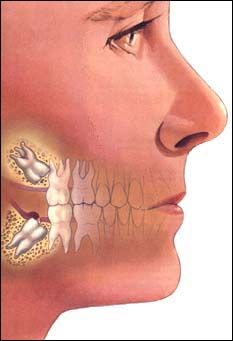 The third set of molars, more commonly referred to as wisdom teeth, typically erupt between the ages of 17 and 21. Unfortunately, the jaw of the average person does not have the room to house these teeth. The result is often dental complications that require oral surgery.
The third set of molars, more commonly referred to as wisdom teeth, typically erupt between the ages of 17 and 21. Unfortunately, the jaw of the average person does not have the room to house these teeth. The result is often dental complications that require oral surgery.
One of the most likely consequences of crowded wisdom teeth is known as impaction. This can consist of two different types, either soft tissue impaction when gum tissue covers the tooth or hard tissue impaction where the tooth is covered by bone. Impacted wisdom teeth will necessitate oral surgery to remove the tooth from beneath the gum and/or jaw bone.
Impacted wisdom teeth can also cause further problems, the most common of which is pericornitis, which typically occurs around teeth that are partially impacted. This means that the tooth is not completely covered by bone or gum and is partially visible. These partially impacted teeth often become breeding grounds for bacteria when plaque and food become stuck in the crevices between the tooth and gum.
Because wisdom teeth are difficult to reach and hard to clean, bacteria can continue to build up and cause infection and irritation. Pericornitis symptoms will often include swelling, difficulties opening the mouth, and pain. Treatment will usually include antibiotic medications, mouth washes, and the removal of the wisdom teeth. Wisdom teeth are also more likely to form cavities due to their location in the back of the mouth. If this occurs, dentists will typically remove the entire tooth instead of just drilling and filling the area of decay.
Wisdom teeth removal can range from a simple extraction comparable to the pulling of any other tooth and a surgical procedure that requires general anesthesia. The extent of the procedure will largely depend on the severity of the impaction. If the wisdom tooth has completely erupted and is not covered by bone, the tooth can be removed in a single piece. However, if the tooth is covered by bone, the gums must be moved away and some bone may need to be removed in order for the tooth to be extracted. In this case, the tooth usually must be removed in several pieces. After the tooth is taken out, sutures are used to sew the gums back into their proper place.
